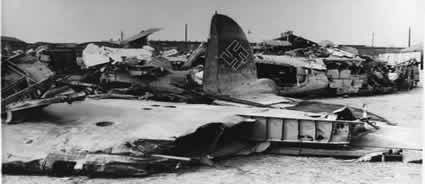Doreen M. Holly's (nee Hewitt) memories
In 1943 (aged 19) I went to work at the laboratory at No.1 Metal and Produce Recovery Depot (MPRD) at Cowley, remaining there until long after the end of the war. No.1 MPRD was one of two Depots (No.2 was at Eaglescliffe, Co.Durham) set up early in the war to salvage everything possible from crashed aircraft.
My father already worked for 50 Maintenance Unit, also based at Cowley, which recovered aircraft from crash sites. He was part of a loading gang using a Queen Mary transporter to bring back wrecks, British and German, to MPRD. He had been a motorcycle dispatch rider on the Western Front during the last two years of World War 1. Thereafter he had a bicycle shop at 39 Cowley Road, which was the Raleigh agency. Now, during the war my mother kept the shop open in the afternoon, and my father did the cycle repairs whenever he was at home. This was in the era when at the end of shifts at the Cowley Works the whole of the width of Cowley Road was filled by a tide of cyclists pedalling homeward.
At MPRD the wrecked aircraft were piled alongside alleyways over a vast area, SE of the Cowley railway line. Usable items and materials were taken from them. The remaining wreckage was then cut up in the main workshops, NW of the railway.

Photo of damaged aircraft at Cowley, reproduced
with permission from Trevor Williams and
taken from "The changing face of Cowley Works Book 2"
by Carole Newbigging and Trevor Williams,
which can be found at http://www.cowleyhistory.org.uk/html.
Aluminium for the manufacture of new aircraft was in very short supply. Hence everything that was made predominantly of aluminium alloys went to the foundry, where it was fed by hand into round pots (later in the war replaced by much bigger furnaces). The molten aluminium was then ladled into moulds to form ingots about the size of two building bricks.
The purity of the recovered aluminium was of crucial importance. Hence, in a small workshop each ingot was sampled by drilling and some of the swarf placed in a numbered paper bag. This then went to the laboratory, which was in a brick building adjacent to the foundry; it had windows but they were blacked out by shutters after dark.
Dr. Bramley had overall charge of this laboratory. Every sample was analysed by spectrophotometry by a specialist group, which included John Neville and Gordon ("George") Parker. This technique could handle the large number of samples. However, 1 in 5 or 1 in 10 samples, taken by John Hart, were checked by conventional standard methods. Analyses were rechecked if significant differences were found.
Mr. E.A. Rayner was in charge of the basic chemistry. Pre-war he had been a chemist in the paint industry. Now he was about 70 years old, living in a caravan at Sandford. In really bad spells of winter weather he moved into the local pub!
For the conventional analyses, weighed sub-samples were taken from the bags, dissolved in caustic soda, filtered, and remaining solid material washed off for analyses. Miss McLoughlan did the copper analyses, Miss Lydia Higgins the zinc analyses, and I did the iron analyses. Analyses for chromium and nickel were also done routinely. Dr. Rayner did any special analyses. These included 'X' samples taken from wrecked German aircraft to determine the nature of the alloys which they were using.
Work in the laboratory was hot and stuffy, but not so hot as in the foundry where the men worked stripped to the waist. One man bore a very large scar on his back caused by molten metal splashed when a ladle fell into a pot.
At lunchtime I got a cooked meal in the canteen on site, which was segregated into 3 categories - directors, staff and workers! This lunch was very useful in supplementing the basic food ration. If there was time after lunch I walked up to Horspath Road to get a breath of fresh air. We had to clock in and out. Often I worked from 8.00 a.m. to 8.00 p.m. If we worked after 5.00 p.m. a high tea was delivered to us to eat in the laboratory. Sometimes, social parties or ENSA concerts were held in the canteen, which made a welcome change from routine.
MPRD, including the laboratory, continued in existence after the war to complete disposal of the accumulated wreckage. During this later period I did a chemistry course for my National Certificate in Chemistry. This was one day a week at the Technical School, first in St.Ebbes and later in Cowley Road - an early form of "day release".
Working at MPRD during wartime and after was an experience, which stood me in good stead later in life.